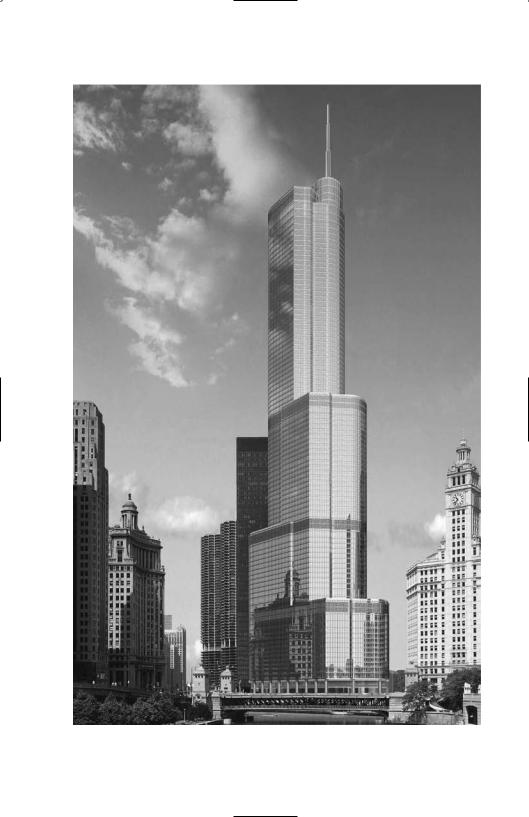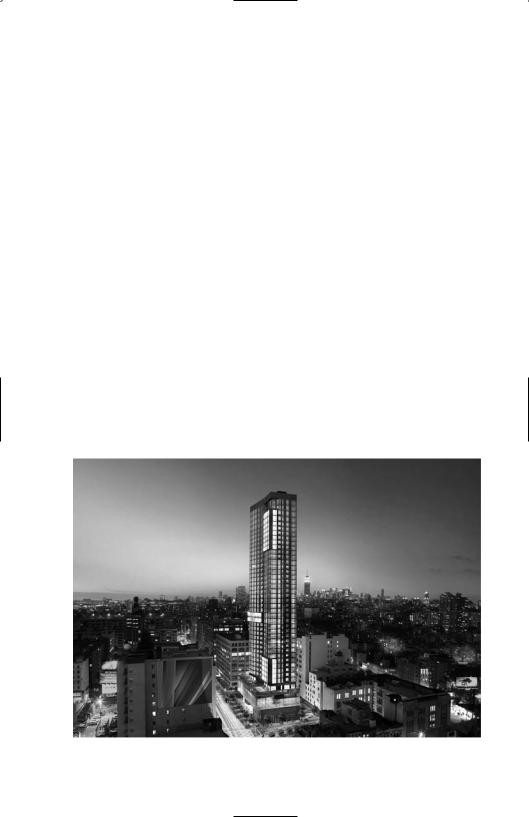
Trump_Never_Give_Up
.pdf
T R U M P : N E V E R G I V E U P
The next problem was that Mark Burnett told me that the most time they would need from me each week to film the show was three hours. Three hours for a prime time show! Amazingly, I believed him. W hen it turned into more like 30 hours, I had some concerns, namely, I was running a huge organization, and already worked about 12 hours a day. How would I handle this? For once, I thought I’d probably overextended myself, big time.
W hat I decided to do was to take it week by week, realizing it would probably need more time initially and that I could live with that for a short time. W hat happened is that it gradually did become part of my daily routine, but my days were definitely longer. I adjusted, everyone adjusted, and it gave me a new form of energy as well. If you are faced with a situation that is demanding of your time, give it a chance to settle in. You’ll be surprised at how much you can actually do each day.
T H E L O W P O I N T
The week before The Apprentice aired for the first time, in January 2004, I remember wondering if that would be the last week of my well-respected life. I couldn’t help but think that, considering all the negative advice I’d been given, although the electric energy we seemed to capture during the shooting was strong. Was it just because it was something new for me? Was it really going to be good? W hat if it was a disaster? How long would it take to recover? There was a huge amount of media attention already. Having a show bomb in that environment wouldn’t be easy to handle. These predebut thoughts were the low point for me because they were justified concerns, not just nerves or negativity. W hat got me through was remembering my gut instinct that said, “This is a great idea—go for it!”
10

T H E A P P R E N T I C E
Fortunately, the show was a sensation. It became the number one show very quickly. Everyone was excited about it and so was I—but I was also relieved. It was a big chance to take. It’s one thing if you’re not well k nown and your show tanks, but if you’re already famous, the sting is worse. If I hadn’t decided to take the risk, go against my advisors, and do the show, none of this would have happened. One side effect is that my brand became far better k nown around the whole world, and there was an amazing media interest in everything I did. That’s another form of free advertising. It worked to my benefit as a businessman as well. So when I advise you to take risks, there’s a reason for it.
C O A C H T R U M P
M A K E I T H A P P E N I N Y O U R L I F E
I often tell people that I listen to everyone, but the decision will ultimately be mine. That’s a good way to be in life and in business. Listen to others, but never negate your own instincts. If I’d listened to everyone, The Apprentice would have never happened. We’ve had six great seasons, and we’re getting ready to tape the seventh now. It continues to be a tremendous experience for me and for everyone involved. Not bad for a big mistake! However, when you do take risks, since they won’t always work out, you better make sure the upside is big.
11

4
I S T H I S A B L I P O R A
C A T A S T R O P H E ?
B e P r e p a r e d f o r T h i n g s T h a t H a p p e n O u t s i d e Yo u r G a m e P l a n
T H E S E C O N D - TA L L E S T B U I L D I N G
I N N O R T H A M E R I C A
We’ve all heard of the Chicago Sun-Times. W hat you might not k now is that they had the best site in the city, right
on the river at North Wabash, next to the landmark Wrigley Building. I wanted it for my Trump International Hotel & Tower/Chicago, and I got it. It’s a fantastic location, and if you visit Chicago and take the architectural boat tour of the city, you will see what I mean. W hen the building comes into sight,
12

Trump International Hotel & Tower Chicago
13

T R U M P : N E V E R G I V E U P
it can take your breath away, and that’s whether it’s windy or not—even though it’s only partially finished and won’t be completed until 2009. Because of the fantastic asymmetrical shape, the building dominates the view from the Michigan Avenue Bridge and nearby West Wacker Drive. If you visit it, you’ll see why we’ve spent so much time and effort on this building.
My plan for the Chicago building began in 2000, and it was announced that it would be the world’s tallest building. I was very excited about this prospect and knew I could get it done, and get it done brilliantly. However, after the terrorist attacks of September 11, 2001, I had the plans scaled down. Much as I wanted to build the tallest building, I don’t think making a building a potential target is a smart idea. So we changed the plan a bit.
That was the beginning of a few changes, in fact. We had Skidmore, Owings & Merrill as the building’s architect, and they built over 50 models before we decided on something we all liked. Then this design was further refined after comments from the Department of Planning, community groups, and architectural critics of Chicago, who were a big consideration. The revisions were done in 2002, and it was approved. Later, in 2004 we changed 10 f loors from offices into hotel rooms and condominiums, based on marketing considerations. We finally began construction on March 17, 2005, five years after I announced the project. You can see by the time line that things don’t happen overnight, even if your name is Donald Trump.
This building will be a big beauty. It will be 2.7 million square feet, 92 stories, and will incorporate a health club and spa, a five-star luxury hotel, condominiums, executive lounges, retail shops, and garages. The penthouses will occupy the three top f loors. It will be the tallest concrete structure and the second tallest building in North America (after the Sears Tower). The hotel is slated to open in December 2007, with the entire building to be finished by the spring of 2009. The cost will be around $800 million. This is a huge project.
14

I S T H I S A B L I P O R A C A T A S T R O P H E ?
T H E L O W P O I N T
There have been some problems—some big ones, naturally. Three months after we began foundation construction, we discovered that water had begun leaking into the building site from the Chicago River. Since the foundation was being laid below the level of the river, it was always a possibility that the old river bulkhead that was already in place wouldn’t hold. However, that wasn’t the problem—water was coming in through a corner where the bulkhead and the Wabash Avenue Bridge meet. This could be a serious problem—so we dealt with it seriously, and it was taken care of. After a while, it is possible to take problems in stride—if you have the right attitude and know what you are doing.
Another element of the building that took an odd turn was the structural design. In the original concept, the base and first 14 f loors of the building were designed to be a structural steel frame, with a reinforced concrete building above. Very late in the design process, as we were bidding the work, we found that there was a huge spike in the world commodity prices for steel due to industrial growth in China absorbing so much of the world’s supply. We went back to the drawing board and redesigned the building as all concrete, saving several million dollars in the process and simplifying the construction logistics.
We also had to consider that the rock caissons (supports) for the tower, which are sunk into the bedrock, make a lot of noise during construction and we hoped that our Chicago neighbors could put up with 241 of them being pounded into the bedrock. About a fourth of the supports had to go down 110 feet into the limestone, so you can see that this alone was a tremendous project. We got it done and didn’t make too many enemies in the process. Because each of the columns carries 14 million pounds, the support system has to be carefully and meticulously thought out and implemented.
15

T R U M P : N E V E R G I V E U P
We had another problem much earlier in the game when we lost our partner, Conrad Black and the Chicago Sun-Times, to a corporate scandal and indictment (and I hope he hangs tough, he’s been through a lot). We made a deal to buy out their interest in the project. More recently, we lost our architect at Skidmore, Owings & Merrill when he resigned from the company. These can be big losses, but you k now what? We just dealt with them and kept moving forward. We are prepared for problems along the way, and like good soldiers we just keep on going. As the general, I have to admit and take responsibility for the fact that things work out as they will, no matter how prepared you are, but we still do our best to plan and focus—then have the resiliency to immediately regroup from setbacks. Our plans and our resolve were strong enough to continue our work without giving in to any interruptions.
There are bright sides to things, too. For example, we saved over a million dollars by reusing the old river bulkhead from the Sun-Times building. We were pleasantly surprised to discover that we had less site cleanup because the newspaper had switched to soy-based ink from petroleum-based ink back in the 1970s, so there was much less ground pollution than we had expected. Sometimes when you start thinking about all the problems you’ve got, it’s a good idea to focus a little on some of the positives in the situation.
C O A C H T R U M P
M A K E I T H A P P E N I N Y O U R L I F E
When things happen that might be outside the outline of your game plan, ask yourself, “Is this a blip or is it a catastrophe?” We had some blips along the way with our Chicago building, and we’ll probably have a couple
16

I S T H I S A B L I P O R A C A T A S T R O P H E ?
more, but it’s still been a fantastic development and experience. Will you have problems when you tackle something big? Yes. Will you let them derail you? You absolutely should not.
Let your passion for your work carry you through all the setbacks they can throw at you. Be it wind, water, resignations, scandals, whatever—you can prevail. Your insurance for overcoming these perils is free—it’s called never giving up!
After a while, it is possible to take problems in stride—if you have the right attitude and know what you are doing. Have the resilience to immediately regroup and change course if you need to after you hit a setback.
17

5
I L O V E A G O O D F I G H T
T h e T r u m p S o H o H o t e l C o n d o m i n i u m
SoHo has been a chic neighborhood for some years now, and I waited a long time to enter it as a developer. I knew it’d be a
fight to get anything going there because most of SoHo is made up of low-rise buildings and is subject to strict zoning laws. I doubt if any of you would think of or refer to SoHo as a manufacturing center, but for historical reasons, that’s how much of it is zoned. So, building a residential structure in the locations I wanted is not permitted. However, you can build a hotel there. W hen I learned that, I decided to build a condominium hotel in SoHo—a tall one.
SoHo is considered a mecca for art, film, and fashion buffs, with over 250 art galleries, 100 designer stores, and over 200 restaurants. In other words, it’s a great area to visit and an even greater area to stay. I believed SoHo deserved—and was ready for—a first-rate, twenty-first-century hotel.
18

I L O V E A G O O D F I G H T
The 45-story, $450 million tower I hoped to build with my partners, Bayrock Group and the Sapir Organization, was, of course, met with a fury of opposition from local community activists and the politicians that represent them. I wouldn’t let that stop us. I announced my intention on June 6, 2006, on The Apprentice. Despite everything that ensued, on May 8, 2007, I’m pleased to report, we were approved by city officials to erect this condo hotel. Along the way, we had a few problems to deal with, which was not a huge surprise.
The biggest obstacle was the height of the building. SoHo is a low-rise neighborhood, and this project would significantly alter the skyline. It would be the tallest building between midtown and the financial district. It’s not that SoHo isn’t zoned for tall buildings—it is—but none have ever been built. We wanted to change that. There were “air rights” laws—the right to build higher—already in place that made it perfectly legal to
Trump SoHo Hotel Condominium New York
19
